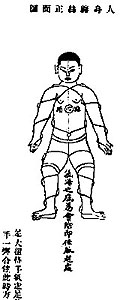Silk Reeling
 Known as Chan Ssu Gong, these unique spiraling movements loosen the 18 joints
and increase range of movement. The key to proper silk reeling is whole
body movement originating from the center, the dantien, and a connection
to the ground, peng jing. These exercises are particularly rehabilitative
for people recovering from physical illness or injury.
Known as Chan Ssu Gong, these unique spiraling movements loosen the 18 joints
and increase range of movement. The key to proper silk reeling is whole
body movement originating from the center, the dantien, and a connection
to the ground, peng jing. These exercises are particularly rehabilitative
for people recovering from physical illness or injury.
Silk Reeling is named for the quality of movement that is practiced. It is said that the movement must be like a spider spinning a web. The spinnerette touches a branch and delicately the silk is drawn out to the next location. If the spider moves too fast or too slow the silk will break and be lost. Movements must be continuous. If an understanding of the body's potential for a natural flow is developed, silk reeling will develop into a deeply satisfying, healing, and beautiful art.
“When one part moves, all parts move”
The dantien, or center of the body, must lead all movement. Silk reeling exercises train the body to move as a whole unit lead by the dantien area. This area of the body is generally not recognized by western anatomy. It operates in Taiji as both a physical location and as an energetic center. It is important that the dantien is not associated with any muscular tension or movement. The dantien can be understood within the body several different ways and as the practitioner gains experience their understanding will improve and change many times.
First and easiest is the idea that the dantien is located in the area between the ribcage and diaphragm and the area where the leg joints join the hips. In this description, there are easily moveable joints on the body that the beginner can usually start to manipulate. The ribcage is moved by flexing and hinging the spine. The ball and socket joints of the legs and hips are rotated.
The dantien is also considered to be an energetic point traditionally said to be located about two inches below the navel that may range in size from a pinpoint to a baseball. This idea of the dantien is nurtured through breathing techniques, Qigong, and intent as well as the physical practices.
Somewhere in between these two definitions--a huge area of the body and a pinpoint of an area, a third concept of dantien arises as a ball of movement guided by intent rather than muscles. The dantien moves independent of the hips and initiates all of the movement in the rest of the torso, legs, and arms. It is this unique concept that separates Taiji from all other forms of movement. Only through proper dantien usage can proper body connection and peng jing, correct force be truly obtained. Chen Taiji teaches the dantien movement though very specific exercises.
It is difficult for us to understand and work with the dantien partly because we are so used to having our mind in our head. But, the mind may be considered to be linked to the whole body, not just the brain. This is called cultivating a mind body connection and all of Taiji develops this skill. Through using the intent to focus the mind on the dantien, energy is gathered which can then be transformed through chigung into spiritual energy or manipulated through peng jing, or a whole body connection for martial purposes.
"In order to understand a move you must practice it 10,000 times.
This
is called The School of Ten Thousand Repetitions."
"The Way is in training."
-- Miyamoto Mushashi
There is no substitute for training. One can have the best instruction in the world, but without practice all of the words and theory are lost.
Once the body understands dantien movement, the rest of the parts of the body begin to move as a reaction to the central spinning. Some say the movements are coordinated to move together but coordination implies a sense of control over all of the parts. In silk reeling, the body is allowed to move naturally, guided by the way the musculature wraps around the bones with a quality of springiness from the tendons and joints. This is not a skill that can be imitated but one that must be cultivated through concentrated use of the dantien.
As the dantien moves, a spiral is initiated throughout the body. This spiral extends upward through the chest to the shoulders, elbows, and wrists and downwards through the hips, knees, and ankles. The joints are guided by the dantien movement, but the spiral is tight with no trailing behind. Understanding peng jing is once again a vital component for proper silk reeling movement.
"Thirty spokes share the wheel's hub;
It is the center hole that
makes it useful."
--Tao Te Ching, Chapter Eleven
Excerpts
from "Illustrated Explanations of Chen Family Taijiquan" by
Chen Xin
[www.chinafrominside.com]